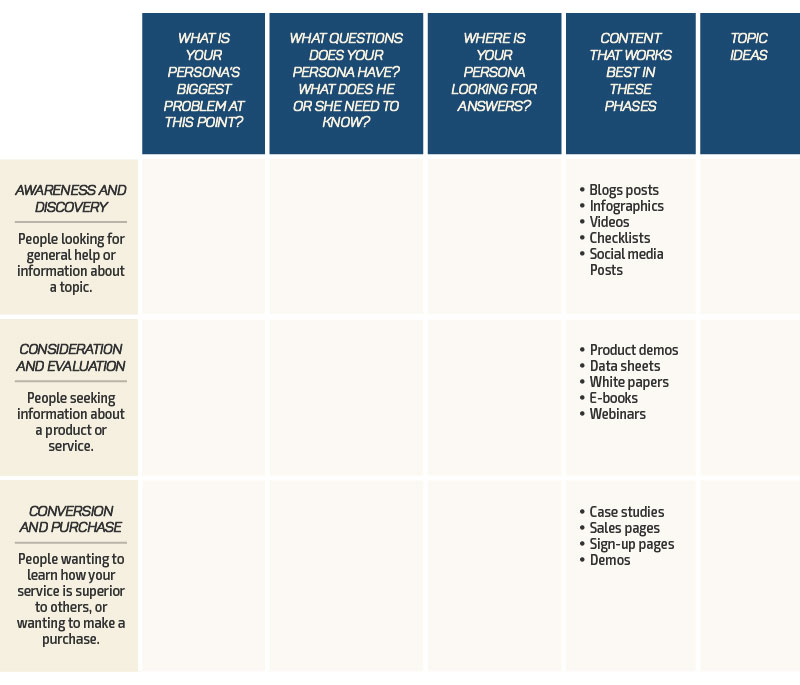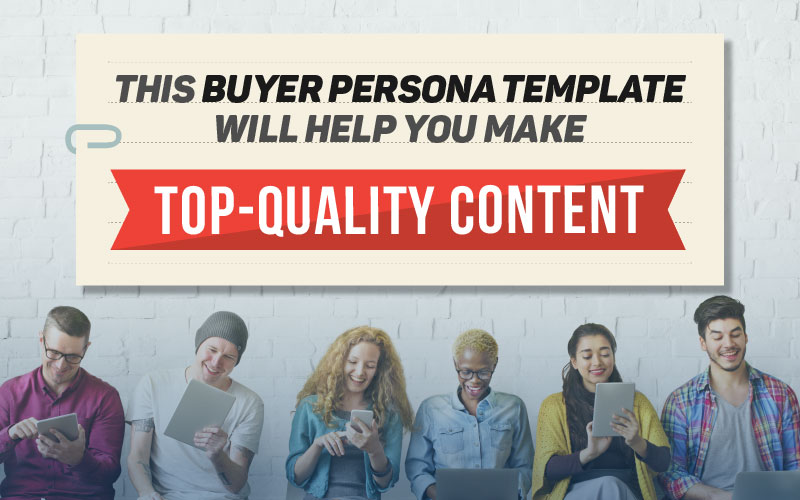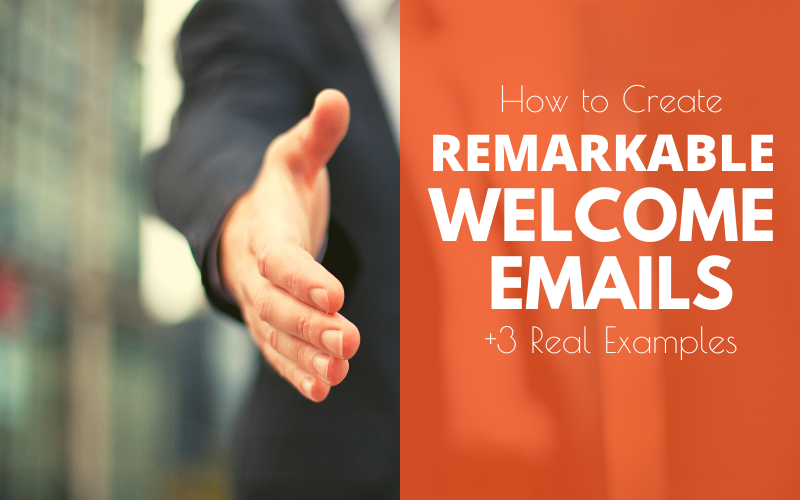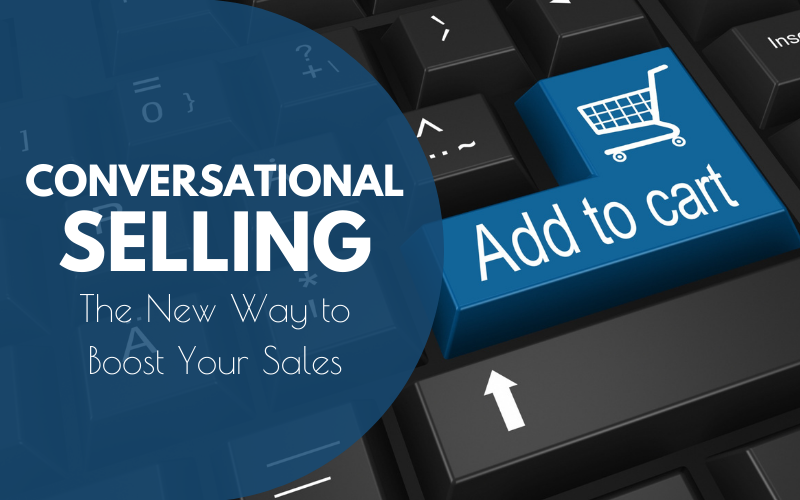While there are many best practices for creating content, there is one rule that will always be the most important: Know your audience.
If you don’t know who you’re talking to, it’s almost impossible to create powerful, targeted content that connects with readers and compels them to take action.
The most effective strategic content is written with one person in mind.
It speaks directly to an ideal customer, and it is created using a buyer persona.
To help you create a buyer persona for your business and improve the quality and effectiveness of your content, use this buyer persona template as your guide.
Download the buyer persona template PDF.
The rest of this post will walk you through the process of filling out the buyer persona template. From what details to add to how to find information about your ideal buyer, this post will help you build a concrete description of your target customer. It will also explain how to use that knowledge to create a content plan that will attract, engage, and convert your ideal prospects.
The #1 rule of content creation: Know your audience
What Is a Buyer Persona?
A buyer persona is a detailed description of a semi-fictional character who is the ideal customer for your business.
Unlike a target audience description that classifies a large group of people, a buyer persona defines one person’s character, values, demographics, problems, and goals. It even goes as far as assigning that person a name and photo in an attempt to bring the persona to life.
Using a buyer persona template to create this character provides a variety of benefits for content development.
- Laser-focused targeting in your marketing plans. When you try to connect with everyone through your content, it comes across as vague and weak. Content created for a single buyer persona is stronger, more targeted, and more effective as a result. It resonates with readers in a way that generalized, ambiguous content cannot.
- A deeper understanding of customers. A detailed description helps a content and marketing team get to know their customer. When they intimately know their customer’s problems and perspectives, they can create more customized, personalized, and useful content.
- More qualified leads. Targeted content attracts the right audience. When your content speaks directly to the people you want to reach, you weed out audiences who aren’t an ideal match for your messaging or offerings. It brings in only qualified, high-quality leads.
So before you create any new content, use this buyer persona template to build a description and image of your ideal customer. Download the buyer persona template PDF.
What’s Included in a Buyer Persona Template?
We’ve created a downloadable buyer persona worksheet to guide you through this process. Each category provides valuable information and a deeper look at your ideal customer.
Demographics
The buyer persona template starts by looking at the personal demographics of your ideal customer. Personal demographics may be less important for B2B companies than B2C companies. But this information is still valuable, as it can help you create a strong image of your target customer.
- Age
- Gender
- Income
- Location
- Family Situation
- Annual Income
- Education
- Professional Role
Once you fill in information about the personal details of your ideal customer, move onto describing their place within their organization. Fill in your buyer persona template with details about your ideal customer’s role at work. Both B2B and B2C organizations can benefit from having this information in their buyer persona.
- Industry
- Job Title
- Company Size
Values and Goals
Now it’s time to dive deeper into the qualities that define your ideal customer’s personality and world views. These factors are also known as psychographics. Fill in details that help you get to know his or her attitude, perspective, and point of view. Ask yourself the following buyer persona questions, and create a bulleted list of his or her values and goals.
- What does he/she believe strongly in?
- What are characteristics of his/her personality?
- What are his/her professional goals?
- What are his/her personal goals?
Challenges
The next section of the buyer persona template outlines the obstacles your ideal customer faces. Knowing these problems will help you create content that offers your audience solutions. Don’t rush through this section. Spend time digging into the specific challenges that are plaguing your ideal customer.
- What are his/her pain points?
- What challenges is he/she facing?
- What is he/she afraid of?
- What keeps him/her up at night?
Sources and Influence
Next, consider where your ideal customer goes to get information to solve his or her problems. List the sources and influences he or she uses and trusts. This information will help you identify what type of content he or she likes and where you can place your content to connect with him or her.
- Favorite blogs/websites
- Favorite magazines
- Favorite conferences
- Favorite books
- Favorite thought leaders
Buying Decisions
The last piece of information in the buyer persona template relates to purchasing decisions. Answers to the following questions will help you define the process your ideal customer goes through before buying. It will also help you set up trigger events and sales funnels.
- What is his/her role in the purchase process?
- How does he/she regularly buy?
- What are his/her objections to purchasing?
Final Details
When all of this information is added to your buyer persona worksheet, you will have a fully formed image of your ideal customer. But to really bring that image to life, add a few final details.
- Give a first and last name to your buyer persona.
- Add a photo that represents the semi-fictional character.
- Add a personal philosophy quote that sums up the attitude and position of your ideal customer.
Once you add these final details, you will have a detailed description of a person who is an ideal customer.
How to Get Information to Fill in a Buyer Persona Template
Knowing how to create a buyer persona is only half of the process. You also need to know how to find accurate, relevant information to fill in the buyer persona template.
While you may feel compelled to fill in details you believe are accurate, it’s better to do research to help create your persona. There are multiple ways to gather information to help you develop an accurate representation of your ideal customer.
Conduct Interviews
The best way to get answers is to ask questions. Conduct interviews with people who can offer insight into questions posed in the buyer persona template. Those people may include:
- Existing customers
- Prospects and leads
- Former customers
- Ideal customers
Ask Your Sales Team
Another group of people who can offer insight into your ideal customer is your sales team. Talk to them to gather information about the questions they typically hear from prospects and to learn more about the qualities of your customers. Work with them to create buyer persona examples that you can later pull details from to develop one cohesive, collective persona.
Use Business Data
Depending on your business, you may have a trove of useful information hidden in your business data. Customer relationship management tools, points of sale systems, and website analytics can all offer insights related to your customer’s habits, wants, and needs.
Listen on Social Networks
To get insight about customers in your industry, engage in social listening (the act of tracking and monitoring conversations on social media). Target terms and phrases related to your industry and offerings and see how people talk about them. Also, use social media as a two-way communication tool, and come right out and ask your ideal prospects questions to gather information about them.
Research Competitor Websites
Competitor websites can often offer a great deal of insight about your target audience. Research websites that share your same ideal audience, and see what you can learn from their data.
This information will help you get a better idea about the habits, interests, characteristics, and demographics of your desired audience. You can use your insights to create a more accurate description of your buyer persona.
Create Multiple Buyer Persona Examples
It’s important to note that you may need to fill out more than one buyer persona template. If you offer very different product lines or offerings, you may benefit from creating one persona for each category within your business.
That is not to say create dozens of buyer personas. It is a detriment to have too many personas. The purpose is to keep your marketing focused and targeted, and you can’t do that with dozens of personas.
But once you create one persona, it’s worth considering if creating two or three more could benefit your business and brand.
Using Buyer Personas to Develop Content Ideas
Once you have one or two detailed buyer personas, you can start outlining the path the semi-fictional character follows on his or her way to doing business with you. You can define each stage of the buyer’s journey.
This map is incredibly useful for content marketing plans, as you can outline the topics you need for each purchase funnel level.
Consider your buyer persona as he or she goes through each segment of the buyer’s funnel and answer relevant questions about his or her needs. Match the persona’s situation with the type of content that works best to create topic ideas.

Once you develop topic ideas based on the perspective and needs of your buyer persona in each phase of the buyer’s journey, there is one more piece of the puzzle: keywords. You need to research the specific keywords your persona is using to search for answers and solutions so that you can target those phrases in your SEO content.
Awareness and Discovery Phase
In the awareness and discovery phrase, target informational keywords and related keywords your ideal customer uses to find solutions to his or her problems or answers to his or her questions.
Consideration and Evaluation Phase
In the next phase, the target customer has already found potential solutions to their problems and answers to their questions. They are in the middle of the buyer’s funnel and trying to decide which brand offers the best tools and resources to give them what they need. In this phase of MOFu marketing, he or she is using navigational keywords to search.
At this point in the process, it’s important for your site to be optimized for terms related to your brand and offerings.
Conversion and Purchase Phase
In the last phase of the buyer’s journey, the persona is using transactional keywords to take them to webpages where they can make a purchase. You want to target buying keywords to help searchers find your pages.
Strategic Marketing Starts With a Buyer Persona Template
When you fill in a buyer persona template and conduct keyword research based on the way your persona funnels through his or her buyer’s journey, you simplify the process of creating content marketing plans. You can clearly see your ideal customer, the path they take to purchase, and the way you can use content to optimize their experience, attract their attention, and guide them through their journey.
So stop guessing about what will resonate with your target audience. Start using a detailed buyer persona to help you execute a more strategic, targeted, and thoughtful content strategy.
Don’t start from scratch as you begin this process. Download our buyer persona template PDF to get the tools you need to quickly and accurately fill in the details of your business’s ideal customer.




